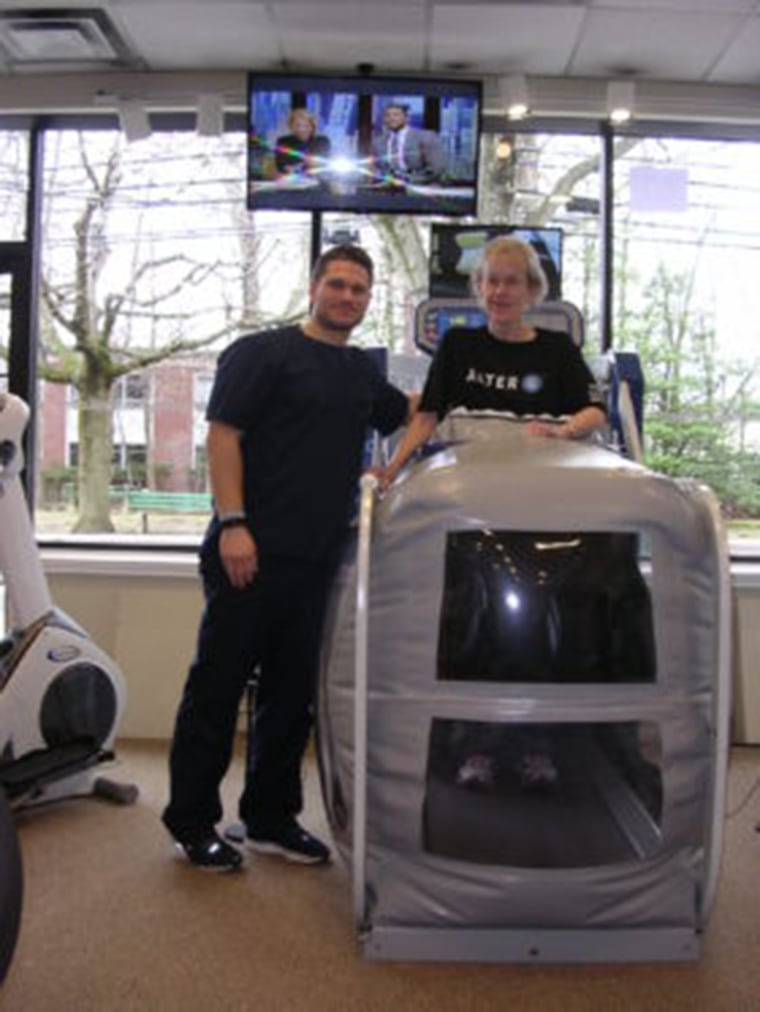As Trish Bogucki walked from her office to her car, she often felt unsteady, tripping and stumbling. She expected it: She had a bunion and a hammer toe that probably needed surgical repair. Finally, the then 66 year-old visited a podiatrist, who surprised her with a very different cause of her condition.
“He said ‘Yep, you have a bunion. Yep you have a hammer toe. But what’s your problem with walking,’” Bogucki, 70, Mahwah, New Jersey, told TODAY.

The podiatrist believed something else caused her shuffling gait.
“He asked me lots of insightful questions,” she said. “He said, ‘You need surgery but I would hate to operate on you and not get at the root cause of the walking problem.’”
He called her general practitioner and explained that he thought Bogucki’s walking issues were neurological. Her doctor then performed two tests: The first was for Parkinson’s disease, which she did not have. The second was for normal pressure hydrocephalus, something she had never heard of before.
Yet, she had it.
“I had all the symptoms. I didn’t realize it,” Bogucki said.
Normal pressure hydrocephalus
NPH is a lesser known and often misdiagnosed form of dementia. It occurs when too much cerebrospinal fluid accumulates in the brain and spinal cord.
“In elderly patients that have a chronic form, it likely evolves over time,” Dr. Mark Luciano, director of the Cerebral Fluid Center, and professor of neurosurgery at Johns Hopkins University, told TODAY.
About 700,000 people have NPH in the United States, according to the Hydrocephalus Association but the group estimates that only 20% of people receive the correct diagnosis. Experts think that NPH is under-diagnosed because its symptoms resemble changes associated with aging, Parkinson's or dementia, including:
- Shuffling, unsteady gait
- Bladder incontinence
- Memory problems
People do not have to have all three symptoms for an NPH diagnosis, though.
“There is some short-term memory loss. It also involves decreases in complex tasks, like executive functioning and communication,” Luciano said."Those symptoms are a little different than Alzheimer’s."
Experts are unsure what causes NPH though doctors sometimes observe a former brain injury, such as a concussion, or a blockage that causes the fluid to build up, for example. They also don't know if it runs in families.
“There isn’t really an exact genetic marker so far,” Luciano said. “There is a greater proportion where it is spontaneous."

While Bogucki sought help because of her impaired walking, she also realized she could no longer multitask. She once enjoyed riding a recumbent stationary bike and solving Sudoku puzzles at the gym but she suddenly couldn’t.
“I could either do the puzzle or move the pedals. I couldn’t do both at the same time,” she said. “You have trouble with processing multiple problems, with decision making … short term memory.”
If doctors suspect NPH, patients undergo an MRI to examine the brain. The next step is to find out if a patient has enlarged ventricles in the brain caused by fluid accumulation, Luciano said.
A proper diagnosis of the disease makes a huge difference for patients — it’s the one form of dementia that can be halted and even reversed in some cases.
Treating NPH
If doctors notice abnormal amounts of fluid, they can perform a lumbar puncture, also known as a spinal tap, to drain some of the fluid. Almost immediately NPH patients, who relied on canes, walkers or wheelchairs, regain the ability to move more independently.
Bogucki couldn’t believe the difference.
“I got relief that night,” she explained. “Once I got the spinal tap I remembered ‘This is what life used to be like,” and I didn’t have to hold onto a wall or a cane or a husband (to walk).”

She knew if she improved from that procedure she could undergo brain surgery where her doctor would insert a shunt in her brain, which would continuously drain the excess fluid from her brain. The shunt helps patients regain their physical abilities and memory long term.
Although she was nervous about the procedure, she wanted to walk again without help and to be able to stand during choir performances.
Since the surgery, followed by physical and cognitive therapy four years ago, she’s taken up line dancing and volunteers as a peer mentor and educator with the Hydrocephalus Association.
“I can multitask again. I can do Sudoku on the recumbent bike,” she said.
Luciano said such impressive results are common.
"Patients show improvements and doctors see people coming out of nursing homes and walking independently," Luciano said.
Bogucki wants to raise awareness of NPH so that others can receive proper diagnosis and treatment.
“The dementia that comes with NPH is reversible,” she said. “I am not perfect, but I wasn’t perfect before anyway.”
CORRECTION (Nov. 13, 2019. 1:02 a.m. ET): An earlier version of this article misstated Bogucki's surgical procedure. Doctors inserted a shunt in her brain, not a stent.